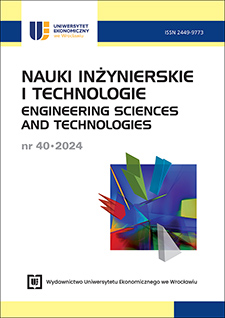New Variant of Cottage Cheese − Use of the Design Thinking Method
DOI:
https://doi.org/10.15611/nit.2024.40.05Keywords:
food design, design thinking, cottage cheeseAbstract
Aim: In today's dynamically developing food market, manufacturers face numerous challenges. In the dairy sector there is a growing interest in innovative products that can interest and attract consumers. The aim of the work was to develop a new variant of cottage cheese using the design thinking method.
Methodology: The method used emphasises placing the consumer at the centre of the design process and taking into account their needs and preferences. The correct implementation of this method includes several stages: understanding the consumer's needs, identifying problems, generating ideas, prototyping and testing.
Results: As a result of the conducted research, the target group was determined and a new product was designed, namely cottage cheese with the addition of pumpkin mousse with a hint of cinnamon. The product was positively assessed during the organoleptic evaluation and recognised as a novelty.
Implications and recommendations: The presented research results suggest that work on innovative food products should be continued, both in terms of the use of commonly known and completely new varieties of plant raw materials with high sensory values for consumers.
Originality/value: The product proposed in this paper is a novelty among the assortment available on the market. The application of the design thinking method to the development of cottage cheese with the addition of vegetables as a sweet addition is the first attempt of this type.
Downloads
References
Antoshchenkova, V., & Kravchenko, Y. A. (2022). Current Trends in Milk Production and Consumption in the World in the Conditions of Globalization. Economic Analysis, 32(2), 7-14. https://doi.org/10.35774/econa2022.02.007
Castanho, A., Brites, C., Oliveira, J. C., & Cunha, L. M. (2024). Food Design Thinking: A Systematic Review from an Evolutionary Perspective. Foods, 13(15), 2446. https://doi.org/https://doi.org/10.3390/foods13152446
Drake, S. L., Lopetcharat, K., & Drake, M. A. (2009). Comparison of Two Methods to Explore Consumer Preferences for Cottage Cheese. J Dairy Sci, 92, 5883-5897. https://doi.org/10.3168/jds.2009-2389
de Paula, D., Cormican, K., & Dobrigkeit, F. (2022). From Acquaintances to Partners in Innovation: An Analysis of 20 Years of Design Thinking's Contribution to New Product Development. IEEE Transactions on Engineering Management, 69, 1664-1677.
European Commission. (2024, October). Short-Term Outlook for EU Agricultural Markets in 2024.
Food and Agriculture Organization of the United Nations (FAO). (2023). Food Outlook Biannual Report on Global Food Markets November 2023 – Milk and Milk Products.
Gadzała, K., & Lesiów, T. (2019). Wybrane aktualne trendy żywieniowe. Praca przeglądowa. Engineering Sciences And Technologies, 2(33), 9-25. https://doi.org/10.15611/nit.2019.2.01
Główny Urząd Statystyczny (GUS). (2024). Dostawy na rynek krajowy oraz spożycie niektórych artykułów konsumpcyjnych na 1 mieszkańca w 2023 r.
Mickiewicz, B., & Volkava, K. (2022). Global Consumer Trends for Sustainable Milk and Dairy Production. VUZF Review, 7(2), 183-192. https://doi.org/10.38188/2534-9228.22.2.19
Olsen, N. V. (2015). Design Thinking and Food Innovation. Trends Food Science and Technology, 41(2), 182-187. https://doi.org/10.1016/j.tifs.2014.10.001
Polski Komitet Normalizacyjny. (2023). PN–EN ISO 8586:2023–10. Analiza sensoryczna — Wybór i szkolenie oceniających sensorycznie.
The District Dairy Cooperative in Piątnica. (2024, November 10).
Tkaczewska, J., Kulawik, P., Morawska-Tota, M., Zając, M., Guzik,P., Tota, Ł., Pajak, P., Duliński, R., Florkiewicz, A.& Migdał, W. (2021). Protocol for Designing New Functional Food with the Addition of Food Industry By-Products, Using Design Thinking Techniques—A Case Study of a Snack with Antioxidant Properties for Physically Active People. Foods, 10, 694.
Von Thienen, J., Meinel, C., & Nicolai, C. (2014). How Design Thinking Tools Help To Solve Wicked Problems. In L. Leifer, H. Plattner, & C. Meinel (Eds.), Design Thinking Research: Building Innovation Eco-Systems (pp. 97-102). Springer International Publishing.
Downloads
Published
License
Copyright (c) 2025 Marta Wilk, Marianna Nowak

This work is licensed under a Creative Commons Attribution-ShareAlike 4.0 International License.





